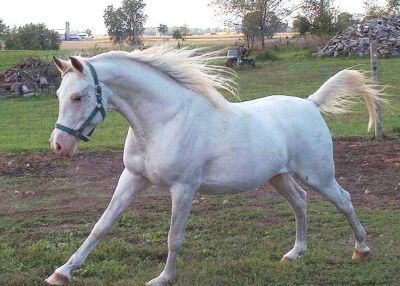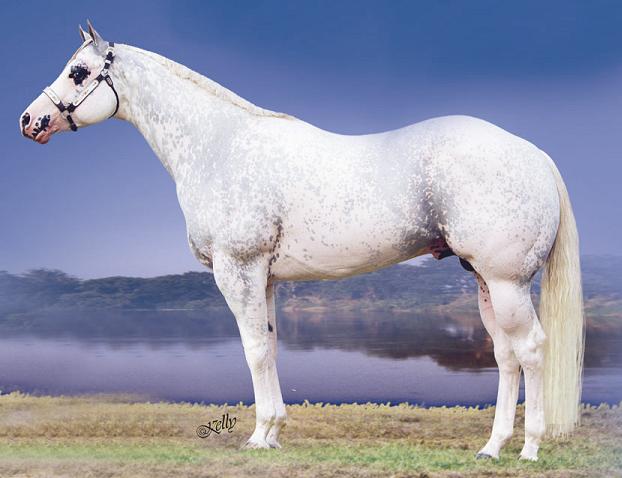Different dominant white mutations occur in different breeds and lines
 We have already seen that dominant white mutations have originated independently on several occasions, so that different mutations occur in different breeds, and even in different lines of the Thoroughbred. So far (July 2009) eleven separate mutations have been characterised and documented in eight different horse breeds.
In mice there are more than 90 known mutations of KIT, and various KIT mutations are known in other animals. Among other things KIT mutations in other animals cause white coat color and spotting patterns, as discussed on the main dominant white page. Some of them are also known to be lethal when homozygous. In horses roan, sabino-1 and tobiano have all also been independently mapped to the KIT gene region on Chromosome 3 (Marklund et al, 1996, Mau et al, 2004, Brooks and Bailey, 2006, Brooks et al, 2007). It is possible that sabino and dominant white are allelic, and maybe even the roan allele (or alleles) too. There's a discussion of this on a another page (see the link below).
Anyone wanting a laymans summary of the basic details of the different mutations should start with Nancy Castle's article, Equine KIT Gene Mutations. ~Dominant White & Sabino ~ at
http://www.duncentralstation.com/PDF/KITGeneMutations-Castle.pdf
Both the dominant white alleles and the sabino-1 allele are variants of the same gene and they could be considered allelic. Read this page for a discussion of the issues where old nomenclature meets with new molecular genetic knowledge.
References for dominant white, sabino white and KIT mutations
Brooks, S.A. 2006. Studies of genetic variation at the KIT locus and white spotting patterns in the horse. Ph.D. dissertation, University of Kentucky.
Brooks SA, Bailey E. 2006. Exon skipping in the KIT gene causes a sabino spotting pattern in horses. Mamm Genome 16: 893–902.
Brooks, S., Lear, T., Adelson, D. and Bailey, E. 2007. A chromosome inversion near the KIT gene and the Tobiano spotting pattern in horses. Cytogenetic and Genome Research 119(3-4), 225-230.
Camarillo White Horse Association. Accessed 23 February 2009. http://www.camarillowhitehorses.org/history_camarillo_white_horses.html
Castle, Nancy. 2009. Equine KIT Gene Mutations. ~Dominant White & Sabino ~ http://www.duncentralstation.com/PDF/KITGeneMutations-Castle.pdf
Castle, WE. 1954. Coat Color Inheritance in Horses and Other Mammals. Genetics 39:33-44.
Cattanach, B.M., 1999. The Dalmatian dilemma: white coat colour and deafness. J. Small Anim. Pract. 40, 193–200.
Gower, Jeanette. 2000. Horse Colour Explained. A breeders perspective. The Crowood Press. ISBN 1 86126 384 8.
Haase, B., Brooks, SA, Schlumbaum, A., Azor, P.J., Bailey, E., Alaeddine, F., Mevissen, M., Burger, D., Poncet, P., Rieder, S., and Leeb, T. 2007. Allelic Heterogeneity at the Equine KIT Locus in Dominant White (W) Horses. PLOS Genetics. http://www.pubmedcentral.nih.gov/picrender.fcgi?artid=2065884&blobtype=pdf
Haase, B., Brooks, SA, Tozaki, T, Burger, D., Poncet, P., Rieder, S., Hasegawa, T., Penedo, C. and Leeb, T. 2009. Seven novel KIT mutations in horses with white coat colour phenotypes. Animal Genetics. http://www3.interscience.wiley.com/journal/122386234/abstract Hintz, HF and van Vleck, LD. 1979. Lethal dominant roan in horses. J Hered 70: 145–146.
Marklund S, Moller MJ, Sandberg K, Andersson L. 1996. Close association between sequence polymorphism in the KIT gene and the roan coat color in horses. Mammalian Genome 10: 283–288.
Mau C, Poncet PA, Bucher B, Stranzinger G, Rieder S (2004) Genetic mapping of dominant white (W), a homozygous lethal condition in the horse (Equus caballus). J Anim Breed Genet 121: 374–383.
Pulos, WL and Hutt, FB. 1969. Lethal dominant white in horses. J Hered 60: 59–63.
Rönnstrand, L. 2004. Signal transduction via the stem cell factor receptor/c-Kit. Cell Mol Life Sci 61: 2535–2548.
Roskoski R Jr. 2005. Signaling by Kit protein-tyrosine kinase–the stem cell factor receptor. Biochem Biophys Res Commun 337: 1–13. |







